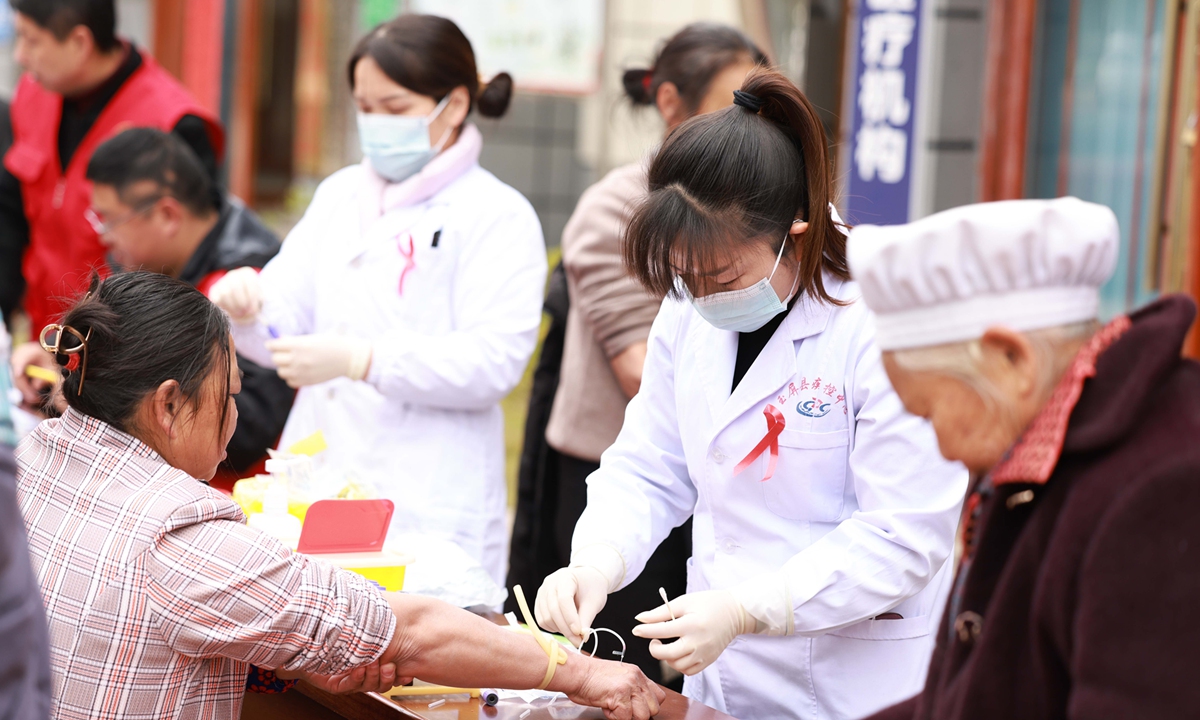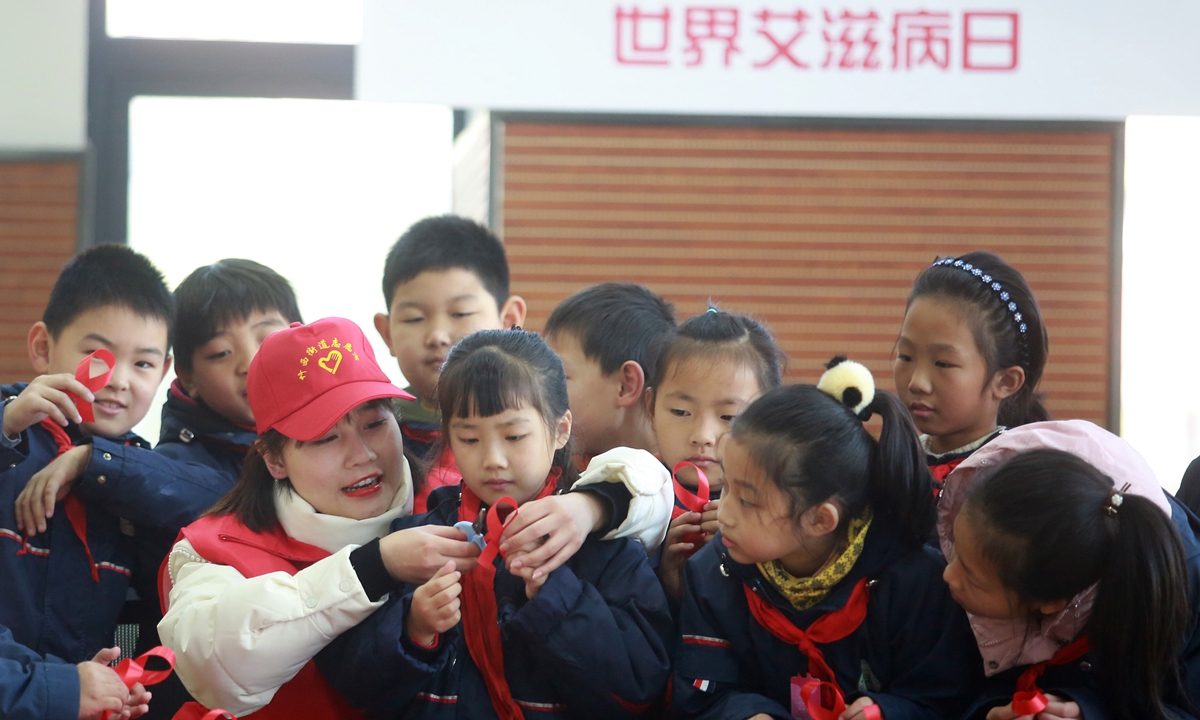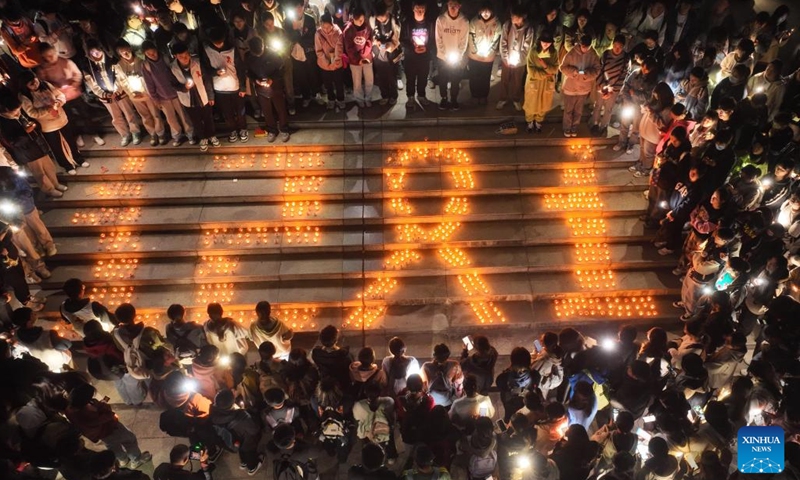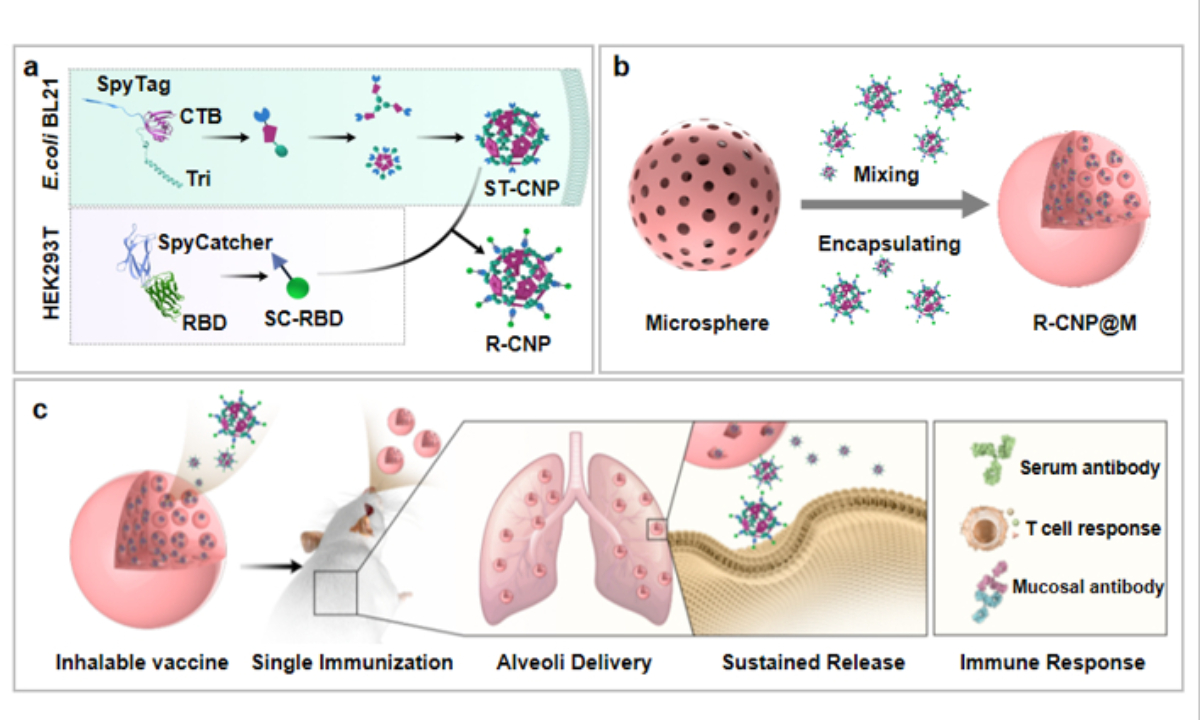
Staff members of local center for disease control and prevention conduct free HIV/AIDS screening for residents in a community in Tongren, Southwest China's Guizhou Province, on December 1, 2023.
After years of efforts, China's prevention and control system for major infectious diseases such as AIDS has improved, and its capacity for disease containment enhanced.Latest data released by the Chinese Center for Disease Control and Prevention (CDC) showed that the HIV infection and mortality rates in China are low on a global scale. Moreover, China has established a national HIV/AIDS treatment and drug supply system covering 2,517 counties. More than 90 percent of HIV carriers have received antiretroviral therapy, and more than 95 percent have achieved success in their treatment.
The awareness of HIV prevention and control knowledge has also increased among key populations in the country. However, there are still many people who are at high risk of HIV infection but reluctant to do virus testing due to social stigma and their own psychological pressure.
March 1 marks the 10th anniversary of Zero Discrimination Day, initiated by then Executive Director of the Joint United Nations Programme on HIV/AIDS (UNAIDS), Michel Sidibé, in 2014 in Beijing. Over the past decade, the day has become an important platform for promoting diversity and inclusiveness, as well as raising awareness about the need to eliminate discrimination in all its forms, especially against AIDS patients and HIV carriers.
In March, AIDS, or acquired immunodeficiency syndrome, became a heated discussion topic on Chinese social media platforms, after Chinese researchers announced a major breakthrough in developing a vaccine against the human immunodeficiency virus, or HIV.
The news coincided with reports of the world's fifth confirmed cured patient of AIDS in the US, bringing a ray of hope for people to completely overcome the disease.
Highly encouraging breakthrough
In collaboration with HKU-Shenzhen Hospital, Foshan University, and the Third People's Hospital of Shenzhen, researchers at the AIDS Institute, Department of Microbiology, School of Clinical Medicine, and the State Key Laboratory of Emerging Infectious Diseases, Li Ka Shing Faculty of Medicine of the University of Hong Kong (HKUMed), found that PD-1-enhanced DNA vaccination can induce sustained virus-specific CD8+ T cell immunity in an AIDS monkey model, according to an article on the HKUMed website on January 31.
The vaccinated monkeys remained free of AIDS for six years and achieved virologic control without the need for combination antiretroviral therapy (cART), a treatment used to suppress replication in individuals living with HIV, according to the article.
The study also found that polyfunctional and broadly reactive effector-memory virus-specific T cells were maintained in the protected experimental macaques for over six years. The findings provide supporting evidence that the programmed death-1 (PD-1)-enhanced DNA vaccine strategy holds promise as a third-generation DNA vaccine for AIDS prevention and immunotherapy, read the article.
"The encouraging outcomes validate the continuation of ongoing clinical trials investigating the potential of the PD-1-enhanced DNA vaccine for achieving HIV-1 cART-free virologic control. Hopefully, the vaccine can be employed independently or in conjunction with other biomedical interventions for individuals living with the HIV in the future," Chen Zhiwei, director of the research, was quoted as saying in the article.
If this efficacy can be replicated in humans, a therapeutic vaccine for cART-free HIV-1 control will be on the horizon. Currently, a Phase I clinical trial, in which the HKUMed team is collaborating with the Third People's Hospital of Shenzhen to test whether the non-human primate data can be replicated in humans, is underway. The report of the trial results is expected to be available in the second quarter of this year.
In the absence of combined antiretroviral therapy, successfully suppressing the virus for six years indicates that these monkeys have achieved a functional cure of HIV. This is an extremely encouraging result in the current field of HIV vaccine development, Lu Hongzhou, head of the Third People's Hospital of Shenzhen, told the Global Times.
But there are differences between the immune systems of humans and non-human animals, especially in response to and replication of HIV, as animal models may not fully simulate the human immune system's response to HIV, Lu noted.
Currently, there have been no rigorously randomized controlled clinical trials globally to validate a high level achievement in a large population. Most candidate vaccines are still some distance away from replicating the same efficacy in humans as in animals. But this is our final goal, Lu said.
PrEPVacc, the only large HIV vaccine study, was halted ahead of schedule because researchers found "little or no chance of the trial demonstrating vaccine efficacy in preventing HIV acquisition," The Guardian reported in December 2023. The trial tested two vaccine regimens along with oral pre-exposure prophylaxis (PrEP), enrolling more than 1,500 men and women at risk for HIV in South Africa, Tanzania, and Uganda.
https://www.theguardian.com/global-development/2023/dec/07/prepvacc-hiv-trial-africa-halted-after-disappointing-initial-results-for-combination-vaccine
HIV's high genetic variability and strong immune escape ability are also two main obstacles in the development of HIV vaccines, according to Lu.
There is still a considerable distance before the HKUMed vaccine can be practically employed in controlling and preventing HIV/AIDS. However, it sends a very positive signal that we are getting a deeper understanding of the virus, said experts reached by the Global Times.
Still a global challenge
AIDS is caused by the HIV that attacks people's immune system.
In June 1981, the first five cases of AIDS were reported in Los Angeles, the US. Since then until 2022, 85.6 million people around the world had been confirmed infection of HIV, with 39 million living with the virus and 630,000 dying of AIDS-related illnesses in 2022, according to data released by the Joint United Nations Programme on HIV/AIDS (UNAIDS). There is currently no effective cure for the virus.
Although anti-retroviral therapy (ART) has proven efficacy in controlling HIV transmission, specialized drugs to cure AIDS and vaccines to prevent HIV infection are still lacked, making the disease/virus remain a major public health challenge to the world.
Currently, the use of pre-exposure prophylaxis (PrEP) drugs has significantly reduced the risk of HIV transmission for non-infected individuals. For those who are infected, many have achieved a near-normal lifespan through long-term Highly Active Antiretroviral Therapy (HAART) treatment. In the field of vaccines, several products have entered clinical trials.
It is expected that in the foreseeable future, the combination of PrEP and antiretroviral therapy will continue to be one of the main methods of HIV prevention and control, with both working together to minimize the risk of infection and disease progression, according to Lu.
Lu believed that vaccines are an ideal weapon to eradicate or significantly reduce overall infection rates. Although there lacks an effective product that can be largely applied, continued investment and research may lead to breakthroughs in the coming years, he noted.
Wu Hao, director of the Department of Infectious Diseases at the Beijing You'an Hospital and medical advisor of the US AIDS Healthcare Foundation's China branch, echoed Lu, stressing the necessity to enhance research in developing preventive vaccines to protect more people before they get infected.
Stem cell transplants are a treatment that has caught a lot of attention in recent years after it was reported to have helped cure five AIDS patients in the world.
"The good clinical outcomes of these patients bring a ray of hope for the complete cure of AIDS, especially for HIV patients with malignant hematologic tumors. However, due to donor limitations, complex procedures, hematopoietic stem cell transplantation is not suitable for large-scale HIV treatment," Lu explained.
Work toward an AIDS-free world
As one of the most populous countries in the world, China's efforts in controlling and preventing HIV/AIDS play a vital role in the realization of the UN's goal to end AIDS as a public health threat, experts noted.
By the end of 2022, China had reported around 1.22 million individuals living with HIV/AIDS, with a cumulative death toll of 418,000 cases since the first case was reported in 1985 in the country, data from the Chinese CDC showed. The number of HIV screening laboratories and testing sites nationwide has expanded to over 50,000.
Yan Jun, deputy director of the Chinese CDC, said in November 2023 at a World AIDS Day promotional event that since 2020, there have been zero reported cases of HIV infection through blood transfusion in China. The mother-to-child transmission rate of HIV in China has decreased to 3 percent the same year.
In response to the first epidemic outbreak of HIV in injecting drug users and the second one by illegal commercial blood collection, China issued the Anti-Drug Law and launched the Blood Donation Act and nationwide nucleic acid testing, which has avoided 98,232 to 211,200 estimated infections and almost ended the blood product-related infection, according to a study published on the Chinese Medical Journal in 2021.
China has been providing free antiretroviral therapy since 2003, which covered more than 80 percent of the identified patients and achieved a viral suppression rate of 91 percent, according to the article.
China has basically cut off the transmission among drug users, mother and children and transmission during blood transfusion. But due to a large population, the number of new infections is still high in the country while the route of transmission is subtler, Wu Hao noted. In the future, more attention should be paid to prevent HIV spread through sexual transmission, especially HIV spread in remote areas and transmission among migrant workers, Wu suggested.
Despite the difficulties, scientists believed that, with the development of science and technology and strengthened international cooperation, an "AIDS-free" world will gradually become a reality.
The Global Times learned from AHF China that, the foundation had signed launched programs in 11 provinces and regions in China including East China's Shanxi and Southwest China's Yunnan. As of December 2023, the foundation had provided 97,472 tests in these places and discovered 2,658 HIV infections. It is also providing treatment and care service to 119,756 AIDS/HIV cases in the country.



